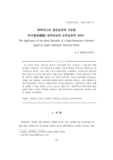

-
 * 본 문서는 배포용으로 복사 및 편집이 불가합니다.
* 본 문서는 배포용으로 복사 및 편집이 불가합니다.
미리보기
서지정보
· 발행기관 : 한국도덕윤리과교육학회
· 수록지 정보 : 도덕윤리과교육 / 51권
· 저자명 : 강수정
목차
Ⅰ. 서 론
Ⅱ. 도덕교육의 내러티브 접근방식과 대안
Ⅲ. 하버마스 담론윤리에 기초한 다시점(多視點) 내러티브
Ⅳ. 다시점 내러티브의 소통구조
Ⅴ. 결 론
참고문헌초록
본 논문의 목적은 내러티브 방식이 도덕교육에 주는 시사점과 그 필요성에 대해
동의하는 입장에서, 기존 내러티브적 방법의 내용과 한계를 분석하고 발전적으로 재
구성하고자 함이다. 이를 위해 다시점 내러티브를 구상하였고, 하버마스의 담론윤리
학을 바탕으로 다시점 내러티브의 소통구조를 체계화하였다. 다시점 내러티브는 어떠
한 사건이나 상황에 대해 관련된 모든 사람의 이야기를 그들의 존재지평에서 들어보고,
전개된 여러 인물들의 이야기들에 내재한 부분적 타당성을 찾아보고, 이를 종합하여 보
편적 타당성에로 나아가는 교육방식이다. 다시점 내러티브는 입체적으로 사태나 상황
을 조망할 수 있는 장점을 지니고 있으나, 한편으로는 상대주의나 회의주의에 빠질
위험도 있다. 이러한 문제점을 보완하기 위해 하버마스의 담론윤리에 기초하여 이론
적 정초를 시도하였다.영어초록
This thesis aims to analyze and constructively reorganize the contents and limits of
existing narrative methods, based on the assumption that narrative methods add to
moral education. It employs a multi-perspective narrative, which systematizes the
narrative communication structure found in Jrgen Habermas' discourse ethics.
A multi-perspective narrative is an educational method that involves listening to the
stories of others from the existential perspectives of those related to a certain
occasion or circumstance in order to discover the partial validity inherent in the
developed stories of the respective characters, and, in putting these together, to
move towards universal validity. Although one can examine an event or situation from
various viewpoints, a multi-perspective narrative does run the risk of falling into
relativism or skepticism. To pre-empt this, the thesis seeks to lay a theoretical
foundation on the basis of Habermas' discourse ethics.참고자료
· 없음태그
-
자료후기
-
자주묻는질문의 답변을 확인해 주세요

꼭 알아주세요
-
본 학술논문은 (주)학지사와 각 학회간에 저작권계약이 체결된 것으로 AgentSoft가 제공 하고 있습니다.
본 저작물을 불법적으로 이용시는 법적인 제재가 가해질 수 있습니다. -
해피캠퍼스는 구매자와 판매자 모두가 만족하는 서비스가 되도록 노력하고 있으며, 아래의 4가지 자료환불 조건을 꼭 확인해주시기 바랍니다.
파일오류 중복자료 저작권 없음 설명과 실제 내용 불일치 파일의 다운로드가 제대로 되지 않거나 파일형식에 맞는 프로그램으로 정상 작동하지 않는 경우 다른 자료와 70% 이상 내용이 일치하는 경우 (중복임을 확인할 수 있는 근거 필요함) 인터넷의 다른 사이트, 연구기관, 학교, 서적 등의 자료를 도용한 경우 자료의 설명과 실제 자료의 내용이 일치하지 않는 경우
“도덕윤리과교육”의 다른 논문도 확인해 보세요!
-
신보수주의의 정치와 도덕 - 영화의 사례 21 페이지
이 글은 신보수주의의 태동을 예비했던 1960년대 미국 영화 한 편과 신보수주의가 본 격적으로 영향력을 발휘하던 1990년대 미국 영화들을 소재로 신보수주의의 정치적, 도덕 적 가치관을 추출해 보려고 한다. 그리고 그에 대한 반례로서 진보적 가치들을 함축한 다른 한 영화를 대조해 본다. 세 가지 작업을 수행한다. 첫째, 신보수주의의 이념적 성격 정리.. -
초기불교에서 인성의 본질과 도덕교육적 의미 - 무아(無我)와 방편적 자아를 중심으로 - 24 페이지
본 연구는 초기불교에 나타난 인성의 의미와 특성을 파악함으로써 인성 이해의 지평을 넓 혀 인성교육에 도움을 주기 위한 것이다. 세월호사건 이후 인성교육이 화두가 되었고, 인공지 능의 등장은 인간의 본질에 대한 성찰기회를 제공하였다. 그러나 ‘인성’ 개념에 대한 보편적 합의의 부족으로 인해 인성교육담론이 공전되어 담론의 방향 설정이 쉽지 않은 상황이다... -
일본의 도덕 교육과정 분석 -도덕의 교과화 과정을 중심으로- 23 페이지
일본의 도덕교육은 세계 1,2차 대전의 전, 후를 기점으로 크게 변화를 겪었으며, 이후 최근 까지의 도덕교육은 1958년 「학교기본법시행규칙」이 개정된 시기부터라고 볼 수 있다. 공립 소・중학교에서 주 1시간씩 「도덕의 시간(道徳の時間)」이라는 영역으로 도덕교육을 실시 해오면서 5차례에 걸쳐 개정을 거쳐, 도덕교육의 실효성에 대한 비판의 목소리가 높아.. -
학습자 중심 수업과 창의적 사고기법을 활용한 도덕과 수업 모듈 개발 43 페이지
변화의 시대에 학생들의 창의적이고 다양한 아이디어 산출과 바른 인성 함양 교육에 대한 중요성이 강조되고 있다. 창의성 교육에 대한 필요성이 범교과적 차원에서 대두되고 있으며 각 교과에서 이루어질 창의성 교육에 대한 연구가 개진되고 있다. 도덕과에서 창의성은 오늘 날과 같은 복잡한 시대에 더욱 중요하다. 창의성과 도덕성의 관계에 대한 고찰은 마슬로우의.. -
신라 화랑도 관점에서 본 김응렴(경문왕)의 화랑정신 19 페이지
필자는 2년 전 「신라 화랑도에 내재한 유교사상」이라는 주제의 연구 논문을 발표한 바 있는데, 그 외연은 신라말기까지 넓혀가지 못한 상태였다. 이번의 연구는 그 후속적 의 미를 가진다. 여기서 주목된 부분은, 9세기 중엽 최고의 화랑이던 국선(國仙) 김응렴(金膺 廉, ?∼875)이 천명하던 겸손·검소·관용의 덕목 즉 ‘삼선(三善)’의 가치를 추구함으로..
문서 초안을 생성해주는 EasyAI

